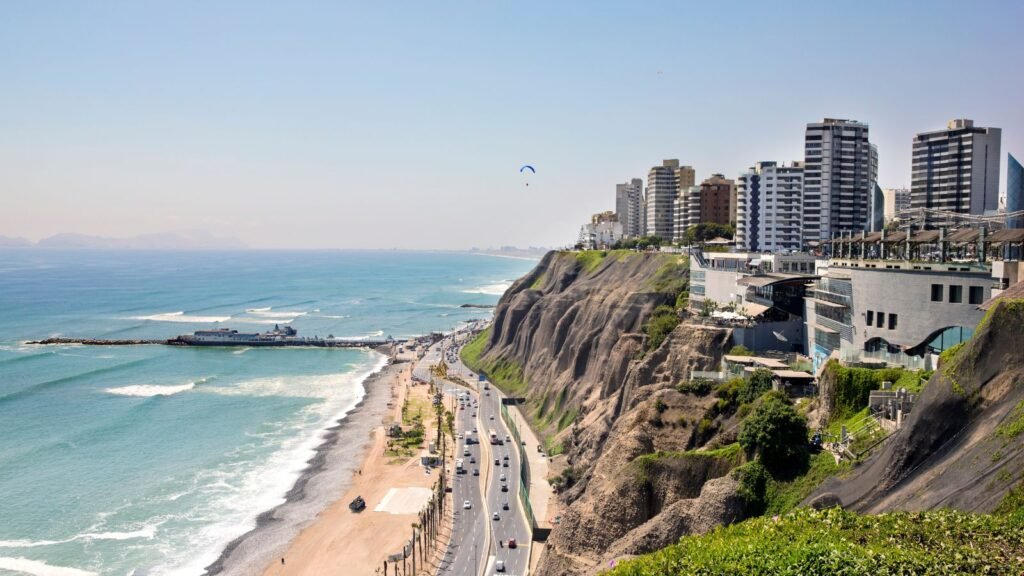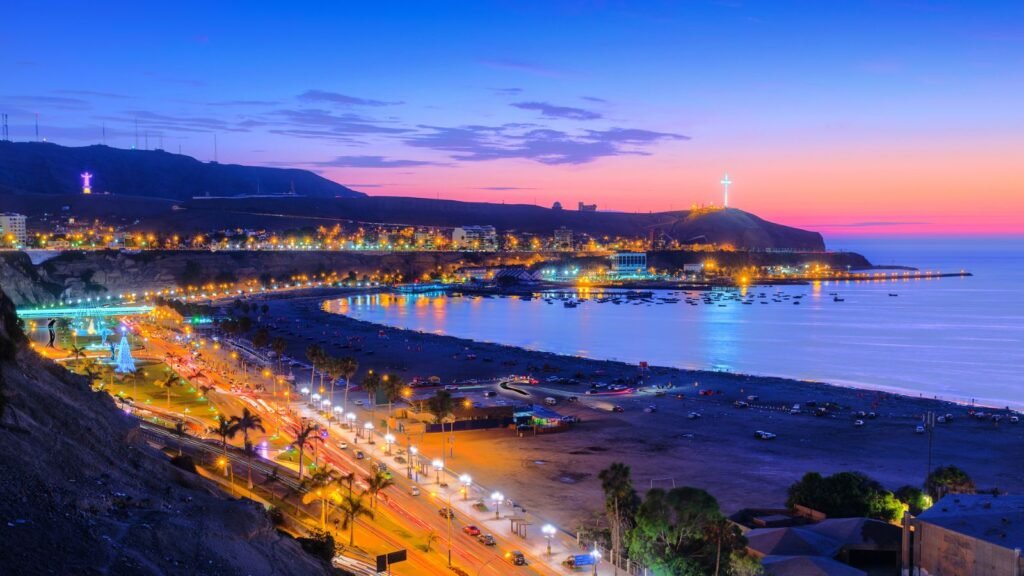Lima smells like sea breeze, sizzling anticuchos, diesel fumes, and the occasional political protest that turns into a street party. A city where colonial balconies, brutalist apartment blocks, and pre-Inca ruins get along like distant cousins at a family reunion that no one RSVP’d to but everyone somehow showed up for. You don’t visit Lima for love at first sight. You visit for the food, stay for the sunsets, and leave still trying to make sense of the traffic, the honking, and the fact that you started calling the fog by its proper name, the “garúa.”
Start at the Plaza Mayor, because every story needs a good opening line and this one is gold-leafed. Lima’s central square, flanked by the mustard-yellow Palacio Municipal and the stately Government Palace, manages to be both theatrical and strangely peaceful — if you ignore the ever-present pigeons plotting an aerial attack and the distant sounds of a brass band warming up for something no one told you about. Wander over to the Cathedral of Lima, which has been rebuilt so many times due to earthquakes that it’s practically the architectural equivalent of a cat with nine lives. Inside, you’ll find the tomb of Francisco Pizarro. Yes, that Pizarro. If you hear clanging chains and the distant weeping of betrayed Inca emperors, that’s just your imagination. Probably. Or maybe just a school group reenactment. They get really into it.

Next door, make your way to the Archbishop’s Palace, with its elaborately carved wooden balconies that look like they were plucked from a Spanish opera set. Peer through the glass into opulent rooms you’ll never be invited into. Then walk a few blocks down to Casa de la Literatura Peruana, once a train station, now a temple to words. It’s quiet, air-conditioned, and filled with books and earnest readers pretending they’re not taking selfies.
From there, meander into the Monastery of San Francisco, a place so drenched in drama it makes soap operas look tame. It has a library straight out of Beauty and the Beast, complete with dizzying spiral staircases and musty books you’d love to sniff if no one were watching. And the catacombs? Bones arranged like interior décor, a design choice that screams: “Baroque, but make it spooky.” You’ll emerge blinking into the sunlight, wondering whether that femur belonged to a saint, a sinner, or someone who just read too much poetry.
Hungry yet? Of course you are. Lima doesn’t do light snacks. It does causas, ceviches, anticuchos, tamales, and arroz con mariscos that will ruin you for food forever. Head to the historic Bar Cordano, a sandwich joint so old it probably served opinions with your jamón. Order a lomo saltado or a butifarra, and don’t rush it. The waiters won’t. There’s no rush. Not in a city where lunch is a performance and digestion is a lifestyle.

Stroll off your lunch with a walk to the Rimac district, if you’re feeling adventurous and your shoes are comfortable enough to outrun the occasional chaos. Cross the Puente de Piedra, which has seen centuries of gossip float across it, and peek at the old colonial mansions, some charmingly decayed, others defiantly intact. The views of the city from the nearby San Cristóbal hill are properly panoramic, assuming the coastal fog known as the “garúa” hasn’t swallowed the horizon like a moody filter. Grab a chicha helada from a cart vendor and feel like you’ve earned it.
Late afternoon is Miraflores time. Uber your way (unless you fancy jousting with combis and microbuses whose driving techniques have been banned in several countries) to the district where limeños jog along cliffs and couples engage in Olympic-level snogging in the Parque del Amor. Gawk at the mosaic walls and the statue of two lovers that looks like it needs a chaperone. Then follow the path to Larcomar, Lima’s most scenic shopping centre — a concrete ode to consumerism embedded into a cliff, with a view that redeems its capitalist soul. Order a pisco sour at sunset from any of the terrace bars. It’s practically a legal requirement. If you’re still upright, grab a lucuma ice cream too.
Evening is for food, again. Because in Lima, every time of day is secretly a prelude to a meal. Make a reservation (because everyone else already has) at Maido or Central, temples of Peruvian cuisine that look like they were designed by minimalists with god complexes. Prepare to be served dishes that resemble geological samples or alien terrariums. Not in the mood for Michelin flirting? Find a cebichería in Barranco, Lima’s artsy district. The ceviche here bites back, the chilcano flows like holy water, and the murals judge you gently as you wobble by.
Sleep in Barranco if you can. It has colonial mansions turned boutique hotels, jazz echoing in alleys, and stray dogs with more personality than most influencers. It’s where Lima stays up too late and regrets nothing. In the morning, stumble out to Puente de los Suspiros. Legend says if you hold your breath while crossing, your wish will come true. Most people just hold their breath because they’re hungover. Take a detour down Bajada de Baños, a narrow path leading to the sea, flanked by art galleries, bohemian cafes, and musicians too proud to admit they work in fintech during the week.
Breakfast like a local at Pan Sal Aire, where the bread is so fresh it might have feelings. Or head to El Pan de la Chola in Miraflores, where coffee is taken as seriously as national elections. Then go full culture sponge at MATE, the museum of Mario Testino. It’s where fashion, photography, and Peruvian sass meet in perfect lighting. A short stroll away, you’ll find MAC — not the makeup store, but the Museo de Arte Contemporáneo. Think bold lines, social commentary, and that inexplicable video installation involving a rubber chicken and interpretive dance.
Now catch your breath and a cab, because it’s time to face the ceviche again. Head to La Mar, a cebichería that feels more like a seafood parade than a restaurant. Order the classic, add some chicha morada, and resist the urge to post every bite on Instagram. Or don’t. Your followers deserve joy. Throw in some conchas a la parmesana for good measure. They’re scallops in cheese, which sounds illegal and tastes divine.
Now it’s time to get prehistoric. Not metaphorically. Catch a cab to Huaca Pucllana, an adobe pyramid casually chilling in the middle of Miraflores, like an ancient god crashed into a middle-class suburb and decided to stay. It’s older than most religions and somehow less visited than the Zara nearby. Take the guided tour — it’s the only way to get past the barriers, and the guides have excellent gossip about pre-Columbian sacrifices. Nearby, there’s even a restaurant with pyramid views, because what pairs better with quinoa salad than ancient ruins?
As the afternoon slinks into golden hour, make your way to the Malecon de Miraflores. Rent a bike, or better yet, don’t. Just walk. Watch paragliders throw themselves into the sky over the Pacific, as if Lima hadn’t enough drama. Join the crowds at Parque Kennedy, where cats rule, churro stands prosper, and musicians compete with evangelical preachers for your attention. Buy some picarones from a vendor — doughnut-shaped, syrup-drenched, and deeply comforting. Eat them like you’re breaking a dietary vow.
End your 48 hours where all good Peruvian nights end: with street anticuchos. Grilled beef heart on a stick, smoky, spicy, and served with a chunk of boiled potato. It sounds wrong. It tastes like home. Wash it down with a bottle of Inca Kola, which tastes like bubblegum and nostalgia, and admire the city that somehow makes chaos look curated.
Lima is a place of layers. Colonial on top of Republican, Inca ruins under car parks, pre-Columbian beneath it all like the city’s original operating system. It doesn’t ask to be loved. It demands to be eaten, walked, argued with, toasted, tripped over, written about, and finally, reluctantly, left behind. But only after one more coffee, one more pisco, and one more “did we really just eat that?”
